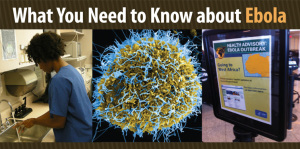By Karla Davis
“Ebola.” What comes to one’s mind these days when hearing that particular word? Perhaps thoughts like “death” or even “breathtaking,” as the disease was described by MCSM freshman, Pahola Orea. This current outbreak has engendered a great deal of fear throughout the U.S., even though Dr, Thomas R. Frieden, director of the federal Centers for Disease and Prevention (CDC), says that “the odds of contracting ebola in the U.S are extremely low.” This statement seems to scare people even more, rather than reducing their fears. This may be due to the fact that this virus is very contagious.
According to specialists at Emory University Medical Center in Atlanta, the virus is present on the patient’s skin soon after symptoms have developed. But this isn’t all that is stimulating fear in U.S. citizens and people around the world. It’s also the fact that further spreading of this disease can be prevented only if someone creates a vaccine or drug approved by the FDA to treat or prevent the deadly virus. Until then, we are told that this non-airborne virus will keep killing thousands of innocent people worldwide.
So what IS Ebola? How is it spreading and what is the U.S doing to make sure that Ebola does not spread?
Ebola has been defined as an “infectious and generally fatal disease marked by a high fever and severe internal bleeding.” It is spread through “contact with infected body fluids”. The current outbreak of Ebola originated in West Africa. As of October 17th, there had been around 17 Ebola cases diagnosed outside the areas where it initially resurfaced. One new appearance that is currently being monitored is the case of the two Dallas hospital workers who have tested positive for Ebola. According to the World Health Organization, popularly known as WHO, the “high rates of infection and the spreading of Ebola among healthcare workers may be due to shortages and or improper use of protective equipment”. The CDC is doing their part to keep Ebola from spreading by sending experts to Texas in order to track down anyone else who may have had contact with Thomas E. Duncan, the Liberian man who was treated by the Dallas hospital workers who became infected. The big question that remains, is will this be enough to avoid the widening scope of Ebola infections?
Student Opinions:
Interviewees: Pahola Orea and Shanice Silva, MCSM Freshmen
Asked how they would describe the Ebola virus, and how they hoped the virus would be managed, Pahola succinctly described Ebola as: “A killer. It kills people and it is slowly spreading in our nation and world.” Pahola expanded on this description by saying that she hopes that the cure for the Ebola virus is found quickly before it’s deadly career goes any further.
Shanice said: “I feel like they [the United States, the CDC,etc] are doing their best right now by trying to limit people travelling between West Africa and here.” Shanice went on to say that she’s not worried because there is advanced technology which people can use to figure out a cure for this disease.
Asked if they were worried that this virus may eventually spread throughout the world (and why or why not), both students were largely optimistic. Pahola responded, “No,” this virus is not going to spread that easily because of new advances in technology.” She went on to explain that various high-tech improvements in disease control will help doctors and scientists figure out a cure for Ebola.
Shanice said: “I’m not worried that that would happen because, a lot of countries now have advanced technology. So they will be able to find a cure before it [the virus], gets too out of hand.”
Asked to describe the Ebola virus in three words, Pahola responded by saying: “Breathtaking, fast, and risky.” Shanice responded with ”Overrated, dangerous, and death.”
Asked if they could change one thing about the way the federal CDC handles this contagious virus what it would be, the girls answered as follows:
Shanice said, “I would make sure that the area where doctors work with infected people is completely sanitized in order for the virus not to spread.” She also suggested that, for instance, whatever equipment that the doctors use should be immediately discarded. Another thing Shanice said she would do is keep the public updated without “scaring” them over the rapid growth of this virus. She further defended her disapproval of how the media is frightening the public by saying that people are currently panicking over something that is “really small.” She feels that people need to hear news reports that are “sugarcoated” or more about cases of the Ebola virus which people have recovered from.
Pahola offered simpler advice, saying that doctors should protect themselves more when treating people with Ebola. Although Pahola’s answer is short and straightforward, it highlights an important fact. . . that clinics and health workers specializing in the treatment of people with Ebola are the most at risk of contracting the disease due to the lack of sanitary protective measures.
